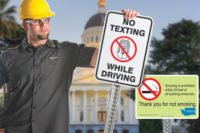- dedicated law enforcement during a specified period,
- paid and earned media that emphasizes an enforcement-based message, and
- evaluation before and after.
NHTSA’s best known and most successful HVE campaign is the Click It or Ticket seat belt enforcement mobilization. HVE has also been effective in combating aggressive driving, impaired driving, and speeding. The demonstration projects were aimed to test whether HVE would be effective in modifying driver behavior to not use hand-held phones to talk or text, whether law enforcement would be able to observe violations, and whether an HVE campaign would increase drivers’ perceived risk of receiving a citation for violating the law.
This report summarizes results from four HVE campaigns during the course of one year targeting distracted driving in Hartford, Connecticut, and Syracuse, New York.
Observed Phone Use in Connecticut
The percentage of drivers observed holding their phones to their ears decreased from baseline to the end in the Hartford and the Connecticut control sites. The reduction was significantly greater in Hartford (from 6.8% to 2.9%) than the control site (from 6.6% to 5.6%). These changes represent a 57% drop in observed cell phone use for the Hartford site compared to a 15% drop at the control site.
Drivers estimated to be between the ages of 25 to 59 accounted for most of the decrease in observed hand-held cell phone use in the Hartford area. There were significant reductions in observed hand-held cell phone use for the two younger age groups; drivers whose estimated age was between 16 to 24 dropped 6.4 percentage points (from 9.0% to 2.6%) while those whose estimated age was 25 to 59 dropped 3.6 percentage points (from 6.8% to 3.2%).
In the control sites, the changes in observed hand-held cell phone use were significant among the middle group (from 6.7% to 5.7%) but not significant for the youngest and oldest age categories (16 to 24 or 60 and above).
Lessons learned
Targeted enforcement using stationary patrols, spotters, and roving patrols can result in high levels of observed violations.
Texting offenders frequently commit other traffic violations, such as land departure, traveling too slowly, or weaving on high-speed highways, providing additional cues to officers.
Public awareness of ticketing for cell phone and texting can be raised in a short period of time. Hartford motorists commented to officers that they “should have known better” given all the publicity surrounding the campaign.
Public awareness of distracted driving is remarkably high, according to NHTSA.
The most difficult challenge to enforcing hand-held cell phone and texting bans is the difficulty in observing the offense.
